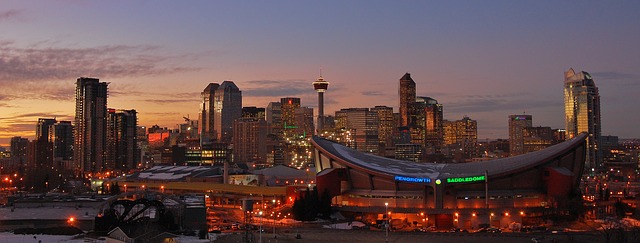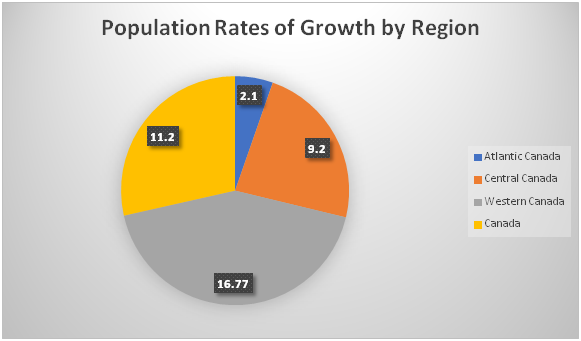Top 25 Fastest Growing Cities in Canada

Is the West going to takeover? Will it become the population centre of Canada? Will it become the power
What are the fastest growing urban centres in Canada? The answer to that question often boils down to which metropolitan area or city has the fastest growing suburbs, because that’s where the growth in population often is. If you’re wondering where to move or which cities to avoid if you don’t care for boomtowns, then here’s a survey of Canada’s fastest growing cities. We’ve also got data on coffee, hockey, and beer. What else could you possibly need to plan your life in Canada?
Let’s start with Statistics Canada’s data on growth rates for Census Metropolitan Areas (CMAs) over both the period 2006 – 2011 and the period 2011 – 2016.
Top 30 CMAs in Canada by Population Growth
Calgary by SmartCanadian99 / Wikimedia Commons / CC BY-SA 4.0
| Cenus Metropolitan Area (CMA) | Population (2016) | Growth (2006-2011) | Growth (2011-2016) |
|---|---|---|---|
| Calgary, Alberta | 1,392,609 | 12.6% | 14.6% |
| Edmonton, Alberta | 1,321,426 | 12.1% | 13.9% |
| Saskatoon, Saskatchewan | 295,095 | 11.5% | 12.5% |
| Regina, Saskatchewan | 236,481 | 7.9% | 11.8% |
| Lethbridge, Alberta | 117,394 | 11.3% | 10.8% |
| Kelowna, BC | 194,882 | 10.8% | 8.4% |
| Guelph, Ontario | 151,984 | 5.5% | 7.7% |
| Victoria, BC | 367,770 | 4.4% | 6.7% |
| Oshawa, Ontario | 379,848 | 7.7% | 6.6% |
| Winnipeg, Manitoba | 778,489 | 5.1% | 6.6% |
| Vancouver, BC | 2,463,431 | 9.3% | 6.5% |
| Toronto, Ontario | 5,928,040 | 9.2% | 6.2% |
| Abbotsford-Mission, BC | 180,518 | 7.0% | 6.1% |
| Ottawa, Ontario-Gatineau, Quebec | 1,323,783 | 9.0% | 5.5% |
| Barrie, Ontario | 197,059 | 5.6% | 5.4% |
| Average Growth for Canada | 35,151,728 | 5.9% | 5.0% |
| Sherbrooke, Quebec | 212,105 | 5.7% | 4.9% |
| St. John’s, Newfoundland | 205,955 | 8.7% | 4.6% |
| Montreal, Quebec | 4,098,927 | 5.3% | 4.2% |
| London, Ontario | 494,069 | 3.7% | 4.1% |
| Quebec City, Quebec | 798,162 | 6.5% | 4.0% |
| Moncton, New Brunswick | 144,810 | 9.5% | 4.0% |
| Brantford, Ontario | 134,203 | 8.7% | 3.8% |
| Hamilton, Ontario | 747,545 | 4.1% | 3.7% |
| St. Catharines-Niagara, Ontario | 406,074 | 0.5% | 3.5% |
| Halifax, Nova Scotia | 403,390 | 4.7% | 3.3% |
| Windsor, Ontario | 329,144 | 4.7% | 3.3% |
| Trois-Rivieres, Quebec | 156,042 | 4.8% | 2.8% |
| Peterborough, Ontario | 121,721 | 2.1% | 2.3% |
| Belleville, Ontario | 103, 472 | 1.2% | 1.8% |
| Saguenay, Quebec | 160,980 | 0.9% | 1.5% |
The data in the above table shows that the West is indeed growing faster than the East of Canada, taking into account that Ontario and Quebec still account for 61.5% of Canada’s population. That’s almost 2/3rds. But this is changing, and in a few decades, it may be that the majority of Canadians will be living in the West of the country. Graphically, let’s see how Canada’s population growth has shifted from East to West.
- The average rate of population growth for Canada is 11.2%.
- Clearly, the Western Canadian provinces (Manitoba, Saskatchewan, Alberta, British Columbia) have a far higher average, weighted rate of population growth than the Canadian average, coming in at 16.77% for the period 2011 – 2016.
- Next, Central Canada (Quebec and Ontario) has a rate of population growth slightly less than the average for Canada, coming in at 9.2%
- Finally, Atlantic Canada has a significantly lower rate of population growth at a mere 2.1%. New Brunswick is the only province to have experienced a net loss of population over the period in question.
Top 25 Growing Cities in Canada
Warman by Canadian2006 / Wikimedia Commons / CC BY-SA 3.0
Let’s now drill down inside individual Census Metropolitan Areas and look at Statistics Canada’s data on municipalities in Canada that are:
- The top 25 fastest growing with a growth rate of at least 15% for the period 2011 – 2016
- Located within a census metropolitan area (CMA)
- Please note that the rate of growth in the table below is for the Municipality in question, not for the overall CMA of which the municipality is part.
| Rank | Municipality | CMA | Growth |
|---|---|---|---|
| 1 | Warman | Saskatoon, Saskatchewan | 55.1% |
| 2 | Cochrane | Calgary, Alberta | 47.1% |
| 3 | Airdrie | Calgary, Alberta | 42.3% |
| 4 | Chestermere | Calgary, Alberta | 34.2% |
| 5 | Beaumont | Edmonton, Alberta | 31.0% |
| 6 | Milton | Toronto, Ontario | 30.5% |
| 7 | Spruce Grove | Edmonton, Alberta | 30.2% |
| 8 | Tsinstikeptum | Kelowna, BC | 29.6% |
| 9 | Sainte-Brigette-de-Laval | Quebec City, Quebec | 29.0% |
| 10 | Fort Saskatchewan | Edmonton, Alberta | 26.8% |
| 11 | Bradford West Gwillimbury | Toronto, Ontario | 25.8% |
| 12 | Martensville | Saskatoon, Saskatchewan | 25.0% |
| 13 | Greater Vancouver Electoral District A (a group of unincorporated areas in the Greater Vancouver Area) |
Vancouver, BC | 24.2% |
| 14 | Leduc | Edmonton, Alberta | 24.0% |
| 15 | King City | Toronto, Ontario | 23.2% |
| 16 | Sainte-Colomban | Montreal, Quebec | 22.5% |
| 17 | Sainte-Catherine-de-la-Jacques-Cartier | Quebec City, Quebec | 21.9% |
| 18 | Ritchot | Winnipeg, Manitoba | 21.9% |
| 19 | Whitchurch-Stouffville | Toronto, Ontario | 21.8% |
| 20 | Langford | Victoria, BC | 20.9% |
| 21 | Paradise | St. John’s, Newfoundland & Labrador | 20.9% |
| 22 | Mirabel | Montreal, Quebec | 20.4% |
| 23 | Saint-Lin-Laurentides | Montreal, Quebec | 19.0% |
| 24 | Carignan | Montreal, Quebec | 18.8% |
| 25 | Shannon | Quebec City, Quebec | 18.6% |
What do we have here?
In the first place there’s a fairly even division between the number of fast-growing municipalities in the East and in the West:
- 13 of the top 25 fastest growing municipalities are in the West.
- 12 of the top 25 fastest growing municipalities are in the East.
- A surprising number of high-growth municipalities are in the province of Quebec, around Montreal and even Quebec City. Their growth rates, however, are at the bottom of the scale, closer to 15%.
As well, if we look into Statistics Canada’s data regarding the total population of the municipalities involved we see that:
- The fast-growing municipalities in the West had a combined population of around 295,000 by 2016.
- The fast-growing municipalities in the East had a combined population of around 385,000 by 2016 despite having one less municipality in the top 25. Milton, Ontario is in large part responsible for this, as its population grew from about 85,000 to around 110,000 over the period involved.
- As far as individual municipalities are concerned, while there is a fair balance between the fastest growing in the East and West of the country, there is clearly a far larger number of municipalities that are growing at a fast rate out West. So, if for example, you’re looking to move to a high-growth area of the country in order to start a small business, perhaps the West offers more opportunities for new entrepreneurs. Having said that, keep in mind that Ontario and Quebec have a combined population of over 60% of Canada’s total population. Any business that does well in Central Canada is off to a great start.
That’s great but where do I get my coffee, buy my beer, or see my favorite hockey team? The Most Canadian CMAs
But growth of residents alone is not enough to measure whether a municipality, or the CMA which it’s part of, is a place you’d like to settle in. There’re social and cultural factors to consider as well. So, to help you choose which fast-growing CMA you’d like to think about living in, we have put together a table with 4 key characteristics that cover nutrition, entertainment, and sports dear to every true Canadian’s heart:
- Coffee: defined by the number of Tim Horton’s franchises in the CMA
- Beer: defined by the number of Craft Breweries in the CMA
- Hockey: defined by whether the CMA hosts an NHL franchise or how far the nearest franchise is to any given CMA without an NHL franchise.
- Opera: defined by the presence of an opera company in the CMA. Fortunately, there’s plenty of opera right across Canada.
We chose a more geographically representative set of major cities across Canada, so a few are not in the top growth cities, but most are.
| CMA | Tim Horton’s Franchises | Craft Breweries | NHL Franchise | Opera Company | Recent Growth |
|---|---|---|---|---|---|
| Calgary | 153 | 11 | Calgary Flames | Calgary Opera | 14.6% |
| Edmonton | 127 | 6 | Edmonton Oilers | Edmonton Opera | 13.9% |
| Saskatoon | 32 | 8 | 485km to Edmonton by air | Saskatoon Opera | 12.5% |
| Kelowna | 18 | 8 | 270 km to Vancouver by air | Opera Kelowna | 8.4% |
| Victoria | 23 | 8 | 97 km to Vancouver by air | Pacific Opera Victoria | 6.7% |
| Winnipeg | 88 | 18 | Winnipeg Jets | Manitoba Opera | 6.6% |
| Vancouver | 56 | 30 | Vancouver Canucks | Vancouver Opera | 6.5% |
| Toronto | 195 | 42 | Toronto Maple Leafs | Canadian Opera Company, Opera Atelier | 6.2% |
| St. John’s | 3 (including 1 in Paradise) | 21 | 1552 km by air to Boston or 1613 km by air to Montreal | Opera on the Avalon | 4.6% |
| Montreal | 92 | 25 | Montreal Canadiens | Opera de Montreal | 4.2% |
| Quebec City | 41 | 5 | 233 km to Montreal by air and then another 2900km to Denver | Opera de Quebec | 4% |
So how do East and West compare in this 11-city table?
- The 7 Western CMAs have far more Tim Horton’s: 497 vs. 331 for the 4 Eastern CMA’s. Look closely at the above table. Do you see it? Yes, there’s a Tim Horton’s in Paradise.
- The 4 Eastern CMAs however, have more Craft Breweries: 93 vs. 89 for the Western CMA’s.
- The Western CMAs have 5 NHL franchises among them, while the Eastern CMAs have 2 seeing that Ottawa did not make our list.
- Opera was everywhere, however. Not one of the CMAs was lacking an opera company.
Clearly it can be seen that while Central Canada still has a disproportionate share of Canada’s population, it won’t be too long before Western provinces begin to approach the 40% mark. And someday they may very well surpass the 50% mark of total population. With growth rates like the ones in cities like Calgary, Edmonton, Saskatoon, or even Winnipeg, the future of Canada does indeed seem to belong to the West. Even if for now, the bulk of the nation’s political and economic power are still east of Thunder Bay.
![Calgary By SmartCanadian99 [CC BY-SA 4.0 (https://creativecommons.org/licenses/by-sa/4.0)], from Wikimedia Commons](https://upload.wikimedia.org/wikipedia/commons/thumb/b/b0/Calgary_Skyline_2015.png/548px-Calgary_Skyline_2015.png)

![Warman By Canadian2006 [CC BY-SA 3.0 (https://creativecommons.org/licenses/by-sa/3.0) or GFDL (http://www.gnu.org/copyleft/fdl.html)], from Wikimedia Commons](https://upload.wikimedia.org/wikipedia/commons/thumb/d/df/Central_Street_Warman_Saskatchewan.jpg/640px-Central_Street_Warman_Saskatchewan.jpg)